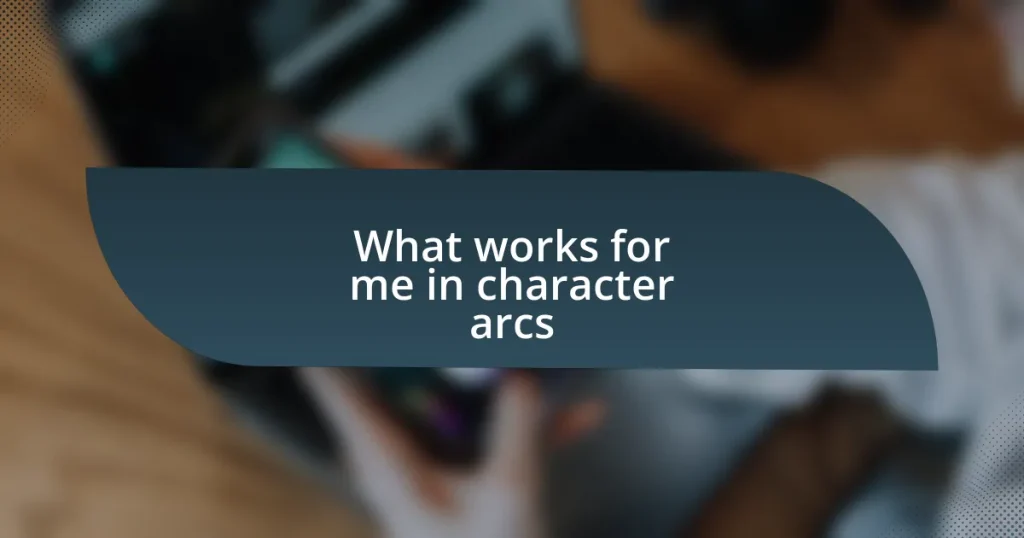Key takeaways:
- Character arcs are crucial for emotional and psychological growth, transforming flat characters into relatable figures.
- Well-developed characters evoke deep emotions, fostering connections between readers and the narrative.
- Different types of character arcs, such as positive, negative, flat, and transformational, shape the dynamics and themes of a story.
- Techniques like setting relatable motivations, creating significant challenges, and utilizing parallel arcs enhance character development and reader engagement.
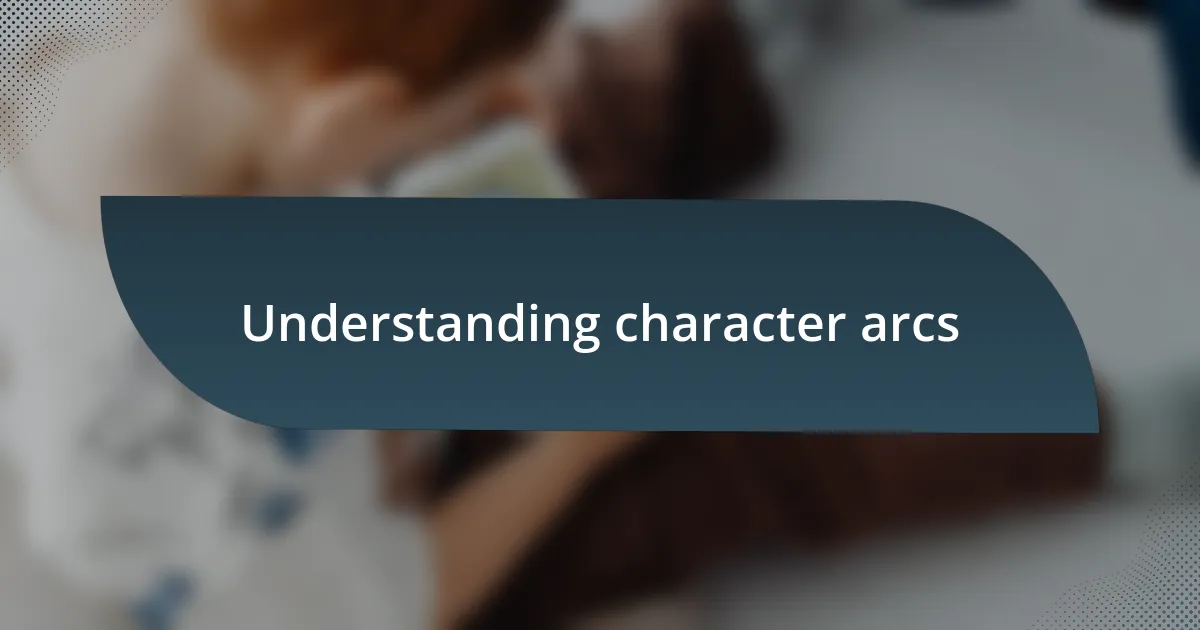
Understanding character arcs
Understanding character arcs is essential for writing compelling stories. I’ve often discovered that a well-crafted arc transforms a flat character into someone readers can relate to. When you think about your favorite characters, have you ever noticed how their journeys resonate with your own life experiences?
Character arcs represent the emotional and psychological growth that characters undergo throughout a narrative. I remember creating a character who started as a selfish individual, but by the end, they learned the value of selflessness. This shift not only surprised readers but also made them reflect on their own personal growth. Isn’t it fascinating how we often find pieces of ourselves in a character’s development?
Moreover, understanding the types of character arcs—like the transformation, the growth, or even the fall—can deepen your story’s emotional impact. I’ve experimented with these different arcs in my writing, and I’ve noticed that the transformation arc often draws me in as a writer. What about you? Which arcs do you find most engaging, and how might they play a role in your storytelling?
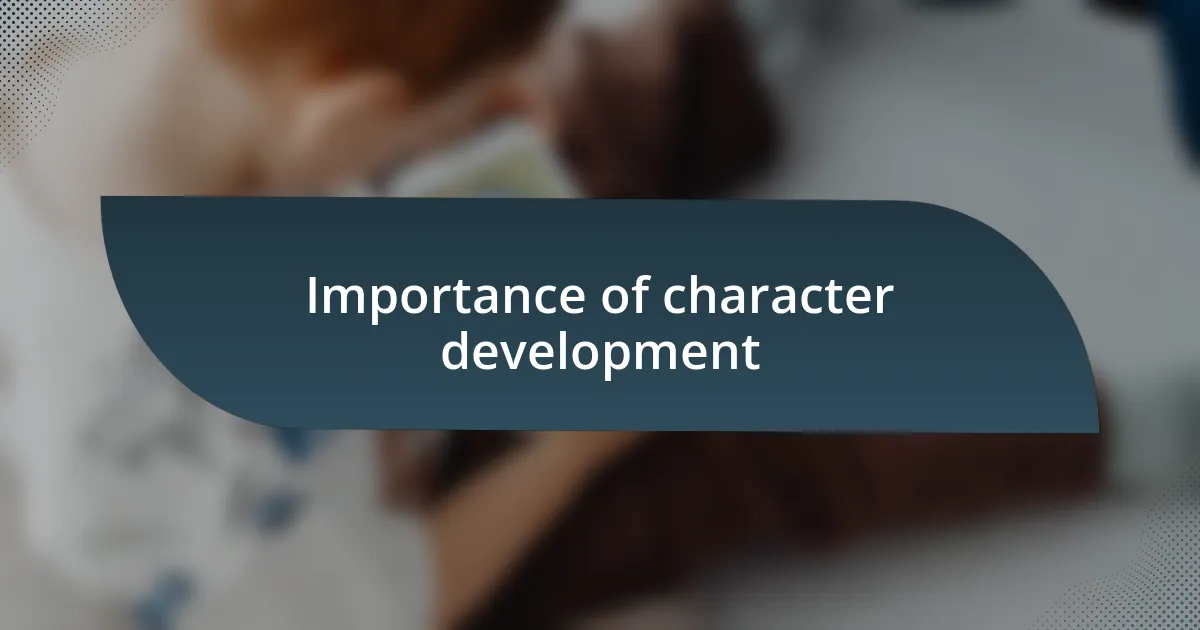
Importance of character development
Character development is fundamental to creating memorable and relatable stories. I often find that well-developed characters can evoke deep emotions from readers, making them feel invested in the characters’ journeys. When a character evolves, whether through triumphs or failures, it mirrors the complexities of real life, fostering a stronger connection between the reader and the narrative.
Here are some key points illustrating why character development is so vital:
- Characters with depth engage readers on an emotional level.
- A clear development path enhances the overall narrative, creating a more immersive experience.
- Readers often see reflections of themselves in well-rounded characters, making stories more impactful.
- Thoughtful character arcs can inspire personal growth in readers as they identify with the characters’ struggles and triumphs.
- Without development, characters may come off as flat, leading to disengagement from the story.
In my own writing, I’ve observed that characters who face challenges and change as a result often resonate the most with my audience. When I wrote about a cautious character learning to take risks, I noticed readers not only related to their fears but also celebrated their eventual courage. It’s moments like these that remind me of the power character development holds in storytelling.
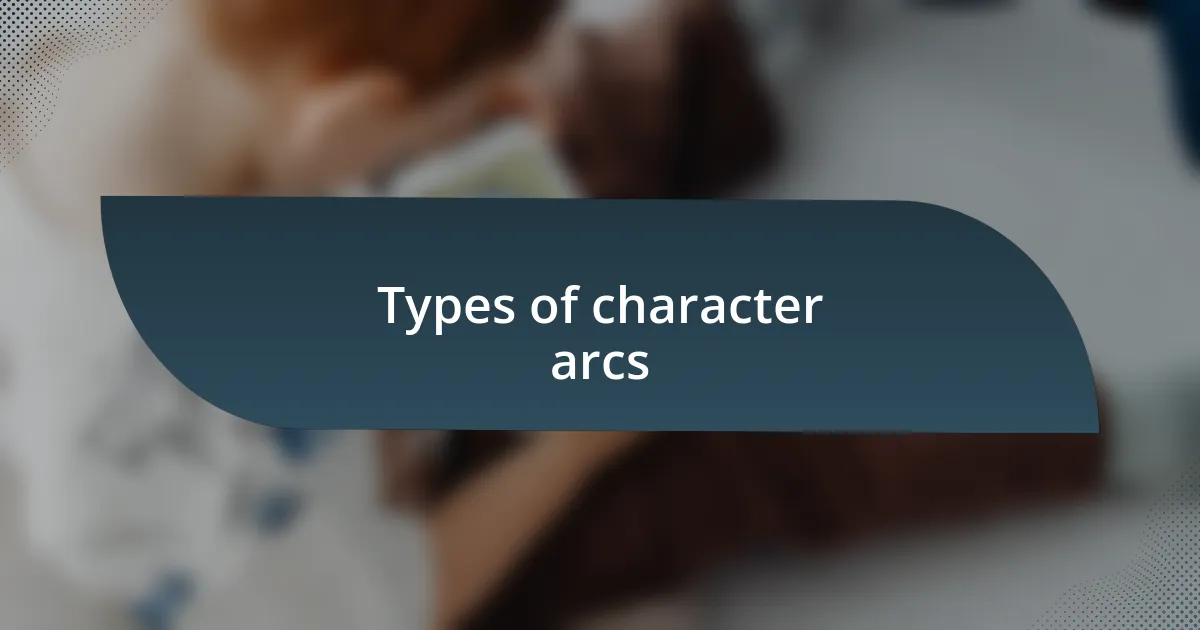
Types of character arcs
Character arcs are vital in shaping the dynamics of a story, allowing characters to either evolve or regress. The two most common types include the positive arc, where a character grows and overcomes obstacles, and the negative arc, where they decline or fail to change despite challenges. In my own experience, I can appreciate how a positive arc can bring warmth to a narrative. I recall a story I wrote about a shy artist who, through various trials, found the courage to showcase her work; it’s a journey I believe many readers can relate to, evoking feelings of inspiration and hope.
Another important type of character arc is the flat arc, which involves a character who remains fundamentally the same while influencing the world around them. This type can be powerful in stories where the protagonist serves as a beacon of truth or stability. I remember crafting a detective character who, despite the chaos around her, held firm to her values and principles. Readers often expressed admiration for her unwavering spirit, reinforcing the belief that strong convictions can influence the larger narrative.
In addition, there’s the transformational arc that blends elements of both positive and negative changes, showcasing a journey of self-discovery. I’ve found that characters who undergo such transformations resonate deeply with readers, as they mirror the complexities of real life. One of my characters grappled with ethical dilemmas, ultimately emerging from those experiences with a renewed sense of self. Such multifaceted arcs provide a reflective lens on our own struggles, allowing readers to find pieces of themselves within the narrative.
| Character Arc Type | Description |
|---|---|
| Positive Arc | Character evolves and overcomes obstacles. |
| Negative Arc | Character declines or fails to change despite challenges. |
| Flat Arc | Character remains the same but influences others. |
| Transformational Arc | Character experiences complex changes, reflecting self-discovery. |

Techniques for effective arcs
When crafting effective character arcs, I’ve often found that establishing clear, relatable motivations is crucial. Take a character I once developed: a single mother fighting to regain her life post-divorce. Her journey resonated with many readers because they could see their own struggles reflected in her determination. Have you ever wondered what keeps readers turning pages? It’s often the depth of a character’s desires that hooks them in.
Another technique I’ve embraced involves setting up significant challenges that force character growth. I remember writing about a young man whose arrogance led him to neglect important relationships. As obstacles began to pile up, he had to confront his flaws and reevaluate his priorities. This realignment not only created tension but also made his eventual growth all the more satisfying. Isn’t it rewarding to witness a character’s transformation through trials and tribulations?
Finally, I believe that using parallel arcs can enhance a story’s emotional weight. In one project, I juxtaposed a seasoned mentor with a young apprentice, both facing their own battles. As they navigated their respective arcs, their interwoven stories created a rich tapestry of growth and learning. By contrasting their experiences, I found that readers could appreciate the nuances of both characters, prompting them to reflect on their own journeys. Have you considered how the relationships between characters can amplify their individual arcs? I find it’s a powerful way to engage the audience on multiple levels.

Creating relatable characters
Creating relatable characters often hinges on the details that make them human. I once wrote a story about a high school teacher navigating the complexities of love and loss. Readers found her struggles relatable because they reflect universal experiences—difficulty in balancing personal aspirations with the realities of life. Have you ever felt torn between your dreams and your responsibilities? It’s this kind of emotional tug-of-war that often strikes a chord with readers.
Another essential element is vulnerability. I remember crafting a character who wore a mask of confidence, but inside, he wrestled with imposter syndrome. Sharing his internal battles allowed readers to connect with him on a deeper level. Isn’t it interesting how revealing our flaws can make us more appealing? I think showcasing vulnerability invites empathy and understanding, which are key to creating strong bonds between characters and readers.
In my experience, diversity in backgrounds and experiences can further enhance relatability. I once created a character from a different cultural background, exploring her unique challenges. Readers responded positively because they appreciated seeing a slice of life that mirrored their own or opened their eyes to new perspectives. Do you think diversity enriches storytelling? I believe that by embracing a variety of experiences, we can connect with a wider audience and make our characters truly resonate.

Analyzing successful character arcs
When I dive into analyzing successful character arcs, I often look for transformative journeys. Take, for example, a character I developed who began as a selfish entrepreneur but evolved into a compassionate leader. This kind of arc speaks to the potential for growth within all of us. Doesn’t it resonate when we witness character transformations that mirror our own personal journeys?
Another key aspect to consider is the conflict that drives change. In a recent story, I featured a character torn between loyalty to her family and her desire for personal freedom. The inner turmoil she faced not only showcased her struggle but also illustrated how conflict can propel a character to evolve. How often do we find ourselves at a crossroads, forced to confront our beliefs and choices? I believe that these moments of conflict are crucial, as they add depth and relatability to character arcs.
It’s also fascinating to reflect on how the setting can influence a character’s development. In one narrative, a character’s redemption arc unfolded against the backdrop of a small, close-knit town. The community’s expectations were palpable, adding layers to her journey. Isn’t it intriguing how external environments shape internal conflicts? I find that exploring these dynamics makes the characters more engaging and their arcs more compelling.
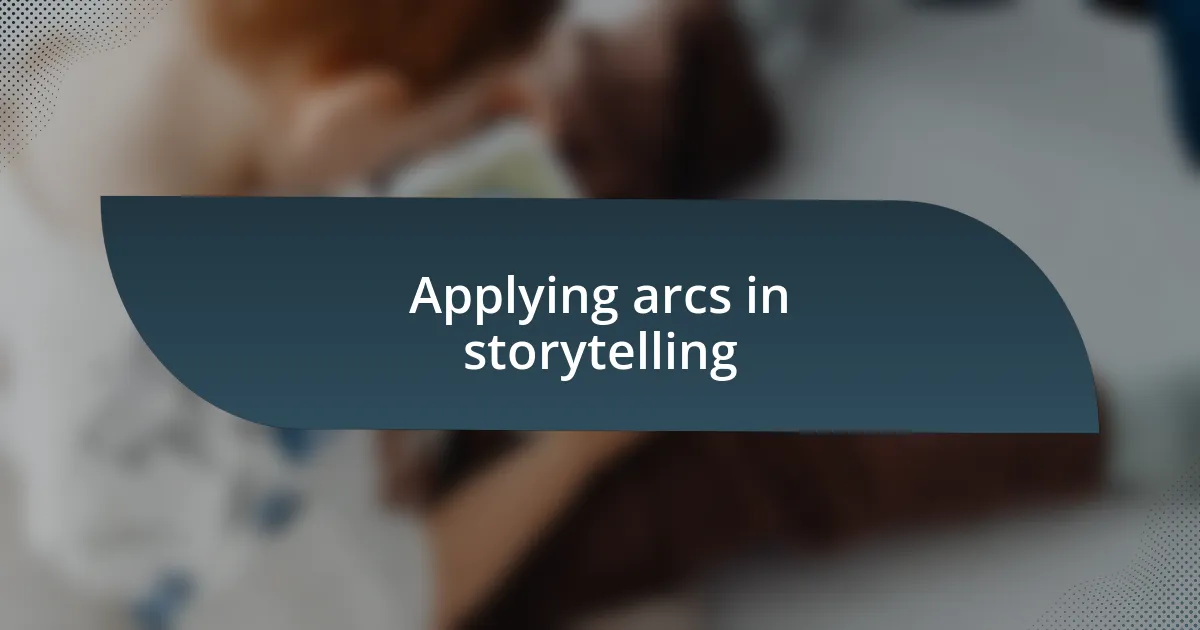
Applying arcs in storytelling
When applying character arcs in storytelling, I often think about how pacing can significantly impact the audience’s connection to the character. I remember writing a story where the protagonist gradually unveiled their vulnerabilities over several chapters, allowing readers to savor each revelation. This approach not only kept readers invested but also mirrored our own gradual process of understanding ourselves. Have you ever noticed how sometimes, the slow unveiling of character traits makes you feel more deeply connected to them?
Another essential element is the resolution, which should feel earned and satisfying. I recall crafting an arc where a once arrogant hero faced the consequences of their actions in a climactic moment. This forced them to confront their flaws head-on and ultimately change their perspective. It’s rewarding to see character growth that doesn’t just happen but unfolds logically through the events of the story. How much more satisfying is it when their growth feels deserved rather than contrived?
Consider how a character’s interactions can illuminate their arc further. In one project, I strategically placed a side character who challenged the protagonist’s beliefs, pushing them toward introspection. This dynamic enriched the main character’s journey and made the themes resonate more profoundly. Isn’t it fascinating how the relationships characters build (or break) can profoundly affect their arcs? I believe that these connections breathe life into the narrative and make development feel organic.











